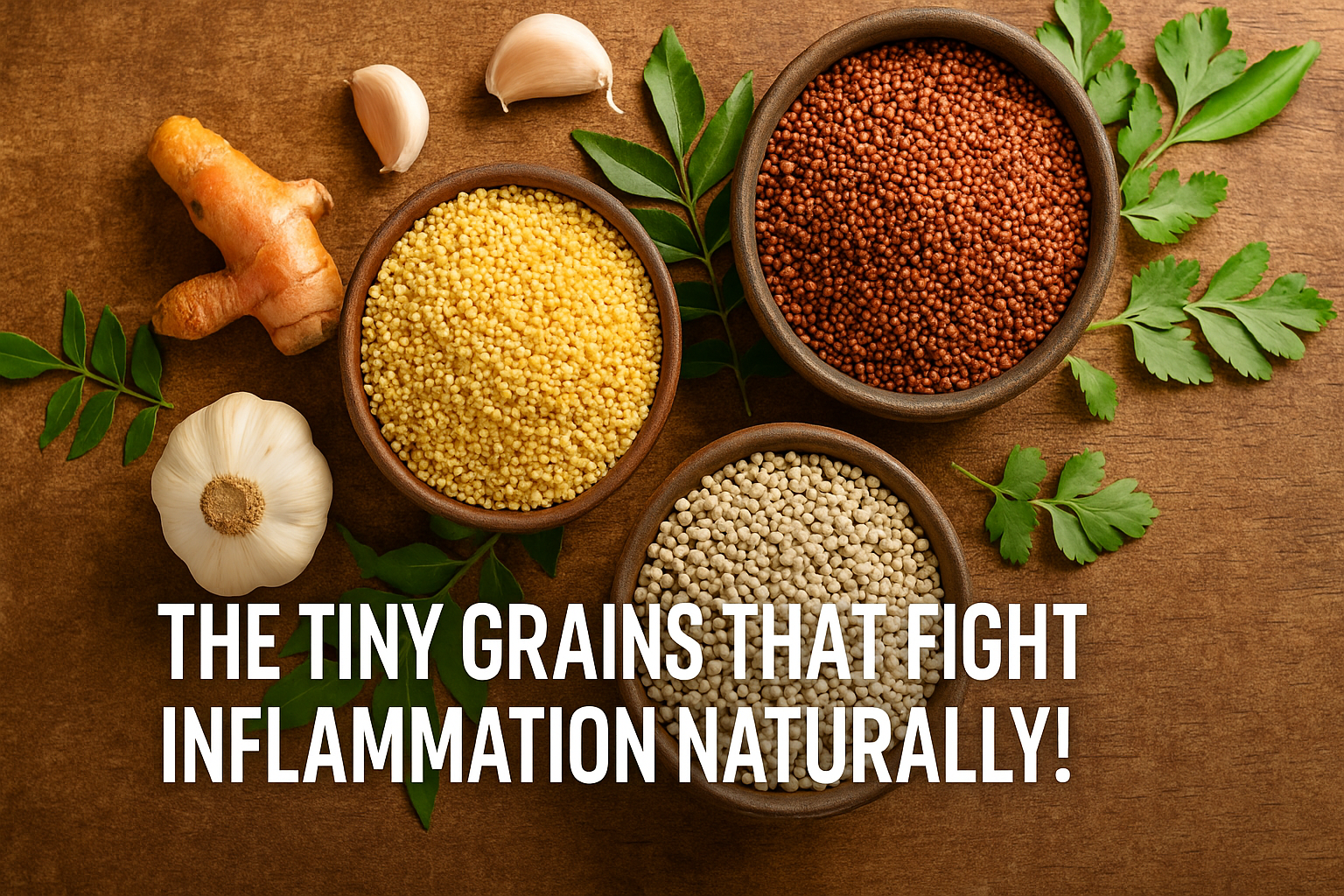It’s not hard to incorporate millets into your diet — just make a few simple swaps. Begin with Best Anti Inflammatory Millets such as ragi (Finger Millet) which is an extremely rich source of iron, magnesium, calcium, and phosphorus also packed with essential amino acids; bajra (Pearl Millet), Foxtail millet. Full of fibre, antioxidants and plant compounds that quell inflammation, these grains are loaded with solutions to everything that ails you. Step 2 Swap cooked millet for white rice in your lunch. It doesn’t weigh heavy on the tummy and fills you up longer. You can even add millets to idlis, dosas, or khichdi for some homely quirk. Pretty neat, right?
Keep millet meals simple and colourful. Mix them with veggies, herbs and a sprinkle of ghee or olive oil. When you sprout or soak them overnight, nutrients are more readily absorbed. Some do even add some millet flour in their rotis — and it works wonderfully! Don’t sleep on hydration; millets can be kind of dry if you skimp on the water, so don’t do that.
Cook them just until they are soft, not mushy. That keeps the texture and flavor just right. Toss in spices such as turmeric and cumin — they’re your natural anti-inflammatory friends. Consuming millets for 3–4 days a week can work wonders. – Don’t over do it though, moderation is the key. Before you realize it, your food will be tastier and your body grateful.
Why Choose Millets for Inflammation Control
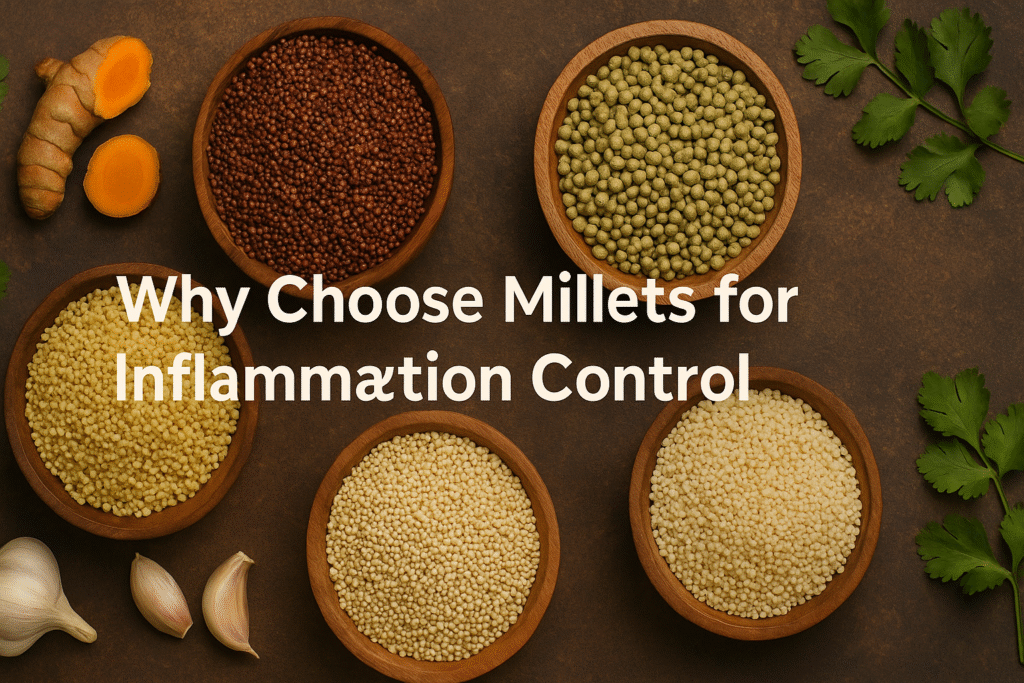
What “Inflammation” Means in the Diet Context
How Millets Supply Anti-Inflammatory Nutrients
Millets are tiny grains with big power. They’re rich in:
• Polyphenols and flavonoids – plant compounds that lower oxidative stress.
• Fiber – supports gut bacteria that reduce body-wide inflammation.
• Magnesium and iron – minerals that help control stress hormones.
• Protein and slow carbs – keep energy steady without sugar highs.
You can cook millets like rice or use them in upma, pongal, or porridge. They blend well with Indian flavors and work for any meal. So, why not switch up your plate a little?
Key Research on Millets and Inflammation in India
Best Millets to Use in an Anti-Inflammatory Diet
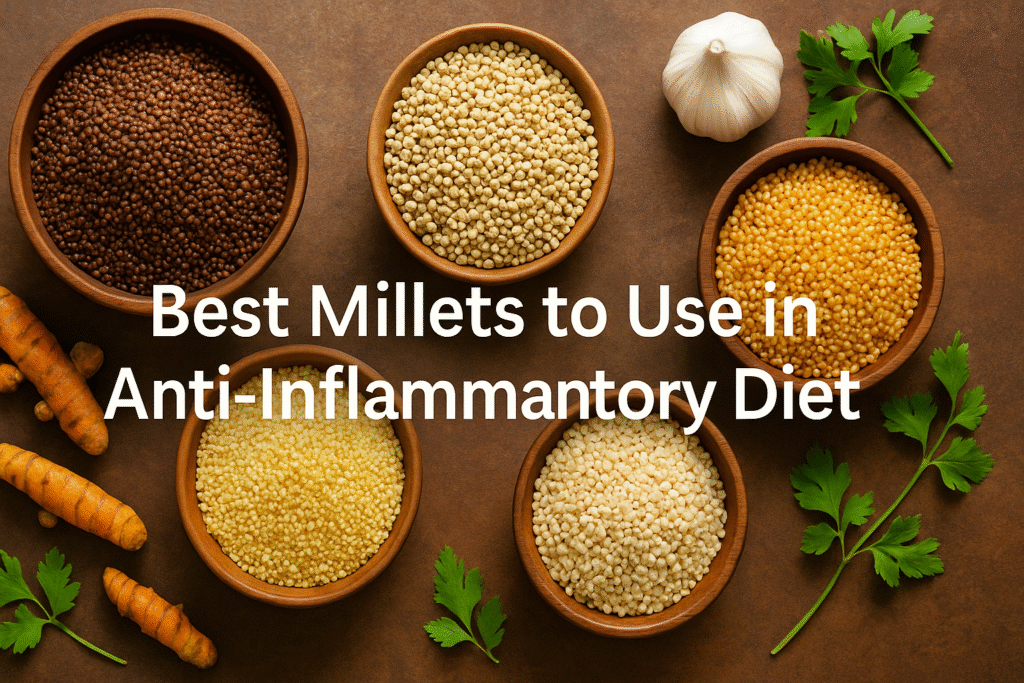
Soaking, Sprouting or Fermenting Millets
If you want to get the most out of millets, do not cook them dry only. Soaking, sprouting or fermenting can make a big difference. After soaking a few hours, millets’ hard outer layer softens, making nutrients more accessible. Not only does sprouting activate enzymes that aid digestion and boost antioxidant power in seeds, but fats also become accessible for use. Fermenting millet batter, the way you would with dosa or idli, builds healthy gut bacteria. Now that is a win for controlling inflammation, right?
Tips for Better Prep:
· Soak in fresh water for 6-8 hours.
· For sprouting, rinse two times a day until little tails develop.
· For added flavor and probiotics, let the batter ferment overnight.
· Cook the soaked millets on low flame always, in order to retain nutrients.
Simple tweaks like these can transform an ordinary millet dish into a gut-friendly superfood plate.
Pearl Millet (Bajra)
Bajra is a power-house grain often used in rural India. It’s packed with fibre and magnesium, which has been shown to lower inflammation naturally. Nor is the next victim.The voter’s anger only grows, winter after winter.
How to Use Bajra:
· Cook bajra roti with ghee for lunch.
· Make khichdi of bajra or pearl millet with moong dal adding turmeric into it.
Have soft bajra porridge with milk and dry fruits.
· Add lemon juice to the food while cooking for optimal iron absorption.
It’s simple, filling, and works well in traditional meals.
Little Millet, Foxtail Millet & Others
These small millets are fluffy, easy to cook and super stomach frienly!
Top Choices:
· Little millet: Best for upma, pulao.
· Foxtail Millet: Excellent for salads and pongal.
· Barnyard millet: It can be used for fasting or detox diet recipes.
Each has its charms, but all these vegetables are high in fiber, antioxidants and inflammation-fighting minerals. They slip into daily Indian meals as if they’ve been there all along.
How to Prepare Millets to Maximise Anti-Inflammatory Benefits

Soaking, Sprouting or Fermenting Millets
Working with millets to their best advantage begins even before you cook them. Douse, sprout or ferment to increase your body’s absorption of nutrients from millets. You release anti-nutrients such as phytic acid when you soak them for 6–8 hours, making minerals more digestible. When a seed starts to grow into a plant in your kitchen, as it would on the earth, enzymes are activated and that process gives millets additional digestive enzymes that are good for your gut and some level of protection from free radicals too. “Fermented millet batters like dosa or idli mix feed good bacteria and reduce gut inflammation.” Sort of a little helper for your tummy, you know?
Quick Tips:
· Rinse in fresh, luke warm water.
· Rinse 1-2 times during the sprouting process.
· Let the ferment sit in a warm place for about 8 hours.
Use the mix 2 days after fermentation for best results
Cooking Methods that Preserve Nutrients
Millets can lose their nutrients when cooked for too long or at high heat. Their vitamins and minerals are preserved with delicate cooking. It is best to steam or slow boil. Do not fry the millet in oil or put a lot of salt into them. Its fine to pressure cook, but don’t over do it. A bit of ghee or olive oil can help with nutrient absorption, so go for that if you like.
Cooking Ideas:
· Steam millet for salads and bowls.
· Boil gently for porridge / khichdi.
· Cook over low heat to retain flavor and texture.
Combining Millets with Anti-Inflammatory Foods
When combined with the right foods, millets can be greater than the sum of their parts. Even better, by throwing in some turmeric, ginger, garlic or cumin to your recipe you’ll get a natural anti-inflammatory punch. Stir in vibrant veggies or leafy greens for additional fiber and antioxidants.
Smart Combos:
· Millet upma cooked with turmeric and vegetables.
· Millet porridge with chia seeds on top.
· Millet pulao with jowar, cooked in spinach and olive oil – served hot.
These are easy combinations, they taste homey (as if someone has been thinking about making you lunch) and they fill you up and relax the body from the inside.
Meal-Planning Tips Using Millets in Indian Context
Example Breakfast, Lunch, Dinner with Millets
It’s easier than it sounds to plan meals with millets. A little swapping, a touch of creativity is all you need. Millets take to Indian dishes like ducks to water and flavors meld beautifully.
Sample Plan:
Breakfast: Ragi dosa with coconut chutney or foxtail millet upma along with veggies.
Lunch: Bajra khichdi prepared with moong dal and turmeric or little millet pulao with curd.
Dinner: Kodo millet porridge with or jowar roti, sabzi and dal.
Rotating from week to week with different millets can make mealtime fun. It’s delicious, filling and maintains energy levels in a steady state throughout the day. Pretty neat, huh?
Snacks and Quick Millet Recipes
Millets are also great for nibbles. They make you feel fuller longer and help to curb those mid-day crap cravings.
Snack Ideas:
· Puffed millet bhel with peanuts and lemon.
· Laddoos made of ragi mixed with jaggery and ghee.
· Foxtail millet tikki with diced veggies.
· Millet smoothie with banana and curd for an instant quick-fix.
You can even combine millet flakes with nuts for snacking. Crunchy and healthy at once.
How to Replace Refined Grains with Millets
Start small to make it feel natural. Replace white rice with foxtail or barnyard millet. Swap maida rotis for jowar or bajra rotis. For desserts, replace maida with millet flour in pancakes or halwa.
Simple Swaps:
· Rice → Little millet
· Maida → Ragi flour
· Bajra roti →Wheat roti
· Poha → Millet flakes
Just mess around until you find the one that strikes your fancy. Gradually, millets are going to infiltrate your kitchen in the best way possible — through one meal at a time.
Nutrient Focus: What Makes Millets Anti-Inflammatory
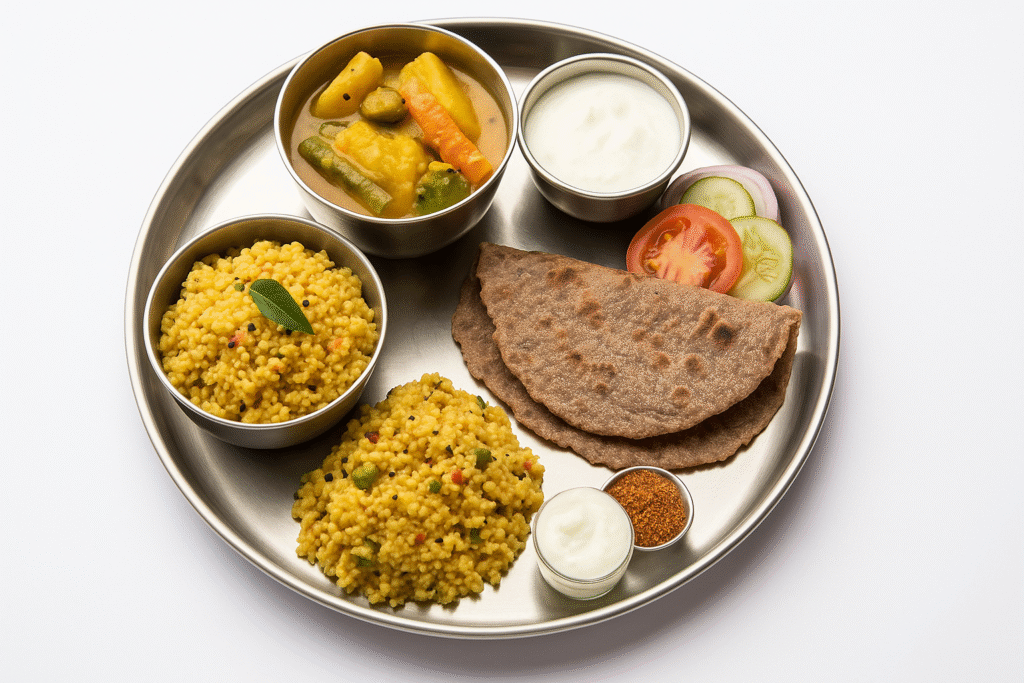
Polyphenols, Flavonoids and Other Bioactives in Millets
Millets appear diminutive, but they are packed with potent plant compounds that help the body stave off inflammation. The actual stars here are polyphenols and flavonoids. These function as natural shields, that protect your cells from a form of oxidative stress. That translates to less swelling, pain and fatigue in the long term. Ragi, foxtail and kodo millets are particularly good sources of these bioactives.
Key Benefits:
· Polyphenols fight distressing free radicals.
· Flavonoids can help balance your immune system.
· Millets regularly consumption can soothe internal stress responses.
A fun fact: Traditional Indian diets have been eating millets as a part of their daily diet long before “anti-inflammatory” ever made its way into the vernacular. As it turns out, our grandparents had a fashion sense ahead of their time!
Fibre, Low Glycaemic Index and Gut Health
Millets are enriched with fiber which plays silent role but stronger. This fibre slows down how sugar gets released into the blood and keeps your gut bacteria happy. Less overall inflammation is a result of having a healthy gut, because it regulates immune responses more effectively.
Why Fibre Matters:
· Maintains a smooth and steady digestion.
· Go feed the good gut bacteria.
· Aids in managing blood sugar and cholesterol.
Millets such as little millet and barnyard millet are excellent for people who have diabetes or weight problems. They fill you up without feeling heavy — I call that a win-win.
Mineral and Vitamin Support for Reducing Inflammation
In addition to fiber and antioxidants, millets are loaded with magnesium, iron, zinc and B vitamins. It support your body in managing stress, repairing tissues and boosting energy.
Top Nutrient Roles:
· Magnesium is also a muscle and nerve relaxer.
· Iron, which helps facilitate the flow of oxygen.
. B vitamins so metabolism and brain balance is at peak.
Eat a mix of millets through the week, combine them with veggies and ghee; you’re doing yourself an anti-inflammatory favour no cream or pill can promise.
Practical Considerations & Common Mistakes
Sourcing Good Quality Millets in India
Quality millet begins with quality sourcing. Not all packs on the shelf are created equal, so it’s worth checking a few things before making a purchase. If you can, seek out organic or pesticide-free millets. Grains that are grown locally are much fresher and more nutritious. Try purchasing from reputable farmer cooperatives or certified online shops. And, yes, sometimes the small local brands are more trustworthy than the flashy ones.
Buying Tips:
· Ensure good color without any blemishes or dirty grains.
· Reject packets that contain dust, stones or have a strange odour.
· Choose vacuum-sealed or air-tight packaging.
· Start with small quantity if you are new to millets.
It’s a good idea to try two or three varieties before deciding your favorite. Each millet tastes slightly different — kinda fun to test them out.
Storage, Cleaning and Processing Tips
And once you’ve got your grains, how you store them makes a big difference. Millets may get spoiled if they come in contact with dampness. Store in airtight jars in a cool, dry place. If you live in a humid city, refrigerate to avoid insects.
Simple Storage Steps:
· Wash unprocessed grains before cooking.
· Remove dust with a mesh with fine hole.
· Store in glass or stainless steel containers.
· Rotate older positions before starting new ones.
And have helped in preserving freshness and nutrition.
Pitfalls: Over-Cooking, Adding Too Much Oil, etc
Even healthy foods can lose their nutritional magic if you cook them the wrong way. Millets get pasty and lose nutrients if they are overcooked. Don’t use too much oil or butter, and keep that light feeling.
Avoid These Mistakes:
· Boil just enough, soft but not mushy.
· Skip deep frying.
· Be aware of portion sizes – less is more!
Take it easy, folks, and stay even keel. That’s the true secret to incorporating millets into your daily diet without all the palaver.
Take-away Tips
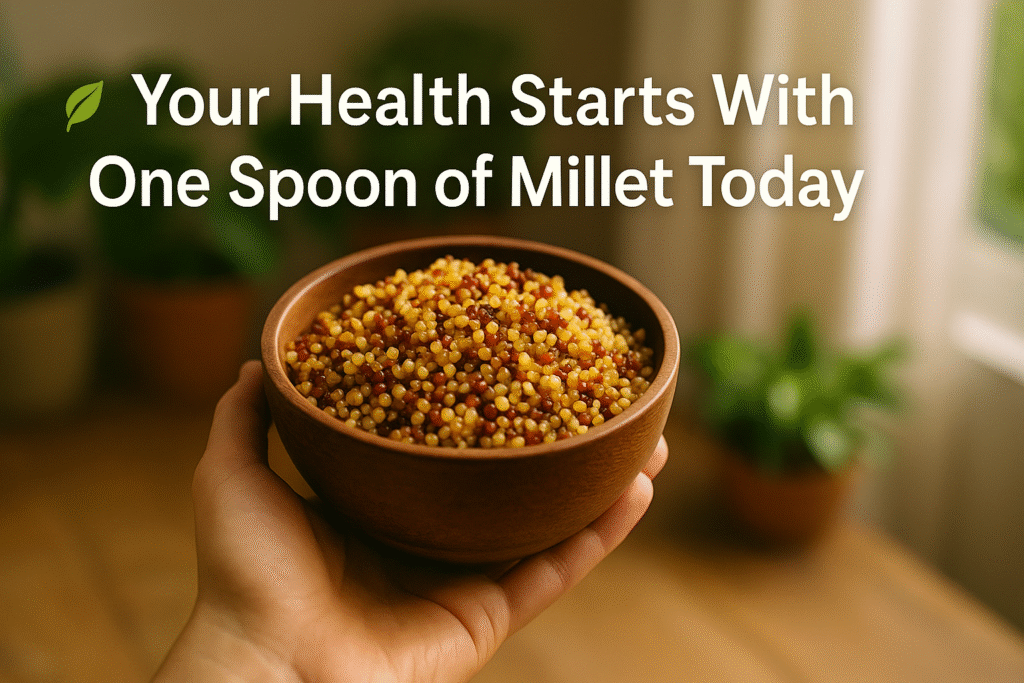
Millets are not just ancient traditional grains, but also your everyday warriors for good health. Using them in your meals will help slowly reduce inflammation, improve gut health and provide you with sustainable energy. The Best Anti-Inflammatory Millets like Ragi, bajra and foxtail millet are readily available and easy to cook. It’s the stuff of Indian legend to say that these little grains have been part of our Indian diet for centuries and now science is coming lub dub up with all their goodness. It feels good to go back to roots, eh?
Three Simple Actions to Start Today
• Replace one processed meal with millet. Swap the white rice or wheat for ragi dosa or bajra roti, for example.
• Grain-mix. Alternating 2-3 millet types India like barnyard, foxtail, and kodo during the week anti-inflammatory grains.
• Add color to your plate. Put millets together with vegetables, turmeric, and curd to get the complete anti-inflammatory punch.
This doesn’t have to be perfect from day one. Just start small and keep with it. That’s the real magic.
How to Monitor Progress and Adjust Diet
Give your body a couple of weeks to adapt. You may find that you digest better, wake up lighter or experience fewer spikes of sugar. If you’re into small bowls, consider keeping a little food diary — annotate which millets you tried, how you felt and what worked best. If your stomach is very heavy cut portion size or soak millets longer.
Everyone’s system is different, so it’s okay to play around as you go. Eventually, your body will lead you — no need to hurry. It’s all about maintaining some level of flexibility and staying well-hydrated — while relishing the natural rhythm of eating better. With a good combi of millets and mindfull eating you will see health to improve from bit to bit day by day

